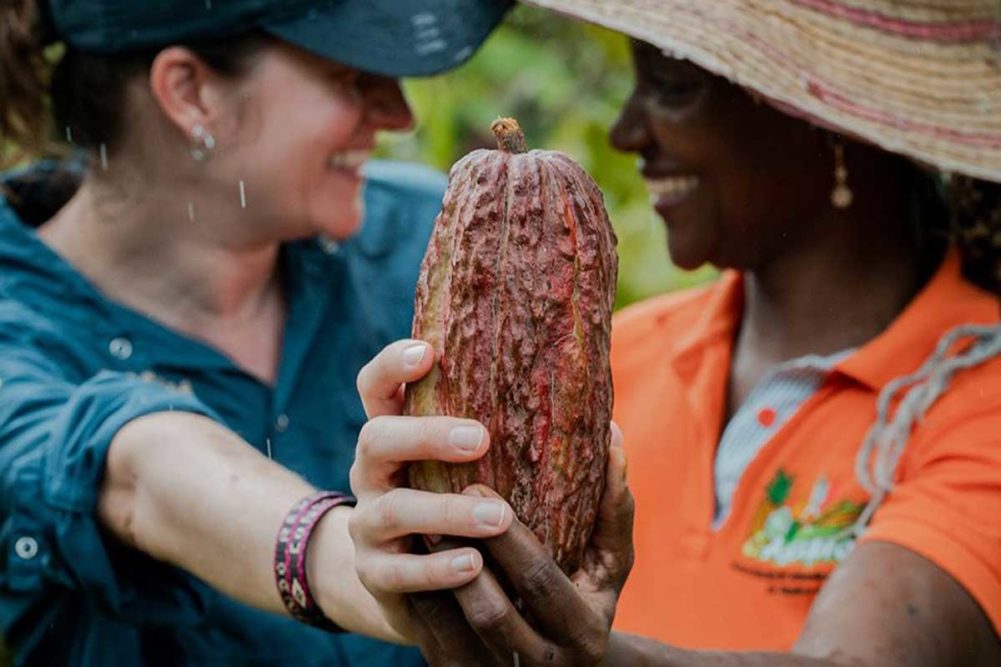GREENWICH, CONN. — GoodSam’s commitment to being a regenerative food company goes beyond improving soil health or sequestering carbon. In fact, sustainable growing practices are nothing new for the indigenous farmers it sources from and does business with.
Founder and chief executive officer Heather K. Terry and her team created GoodSam Foods in 2019 with the goal of bringing high-quality cocoa products from Colombia to the US market. They built a supply chain free from brokers and middlemen, working directly with growers who, due to their geographic isolation and lack of access to chemical outputs and machinery, use traditional farming practices that are inherently regenerative. That looks different for each farm, but ultimately, it means the growers promote biodiversity, cycle carbon into soil and preserve their area’s natural ecosystems.
“These indigenous farmers have been practicing their way of farming for many generations,” Ms. Terry said. “For them, it isn’t regenerative agriculture. It’s just farming. That’s lost on us as a Western audience because we tend to think we invented these things.”
GoodSam aims to protect and strengthen existing farming systems by addressing specific challenges facing its communities. Such an approach requires a level of decentering that many Western organizations struggle to achieve.
A consumer products veteran with 15 years of supply chain experience, Ms. Terry encountered this dynamic firsthand during trips to developing countries throughout her career.
“One thing I heard repeatedly in the field was, ‘We get the fair trade premium, which is great, but then these groups will make us build a community center or make us build a well, even if that’s not what we need,’” she said. “As Westerners, we often go into these communities and say, ‘Here’s the photo op I need.’”
GoodSam doesn’t condemn fair trade certification, and it still pays its farmers an above market price for their crops. Its direct-trade model takes funds that would go to third-party intermediaries and lets farmers decide for themselves what investments are needed on their land and in their communities. Garbage removal, heavy metal testing and home improvements are just some of the “less Instagrammable” projects it has invested in.
“We’ve done things like reinforce doors in rural communities so important items aren’t stolen,” Ms. Terry said. “That’s not very photographable, but if you live in a rural community where guerillas and Narcos still operate, it’s an important investment.”
Beyond chocolate
GoodSam started by sourcing cocoa from Colombia, launching its first line of chocolate products in 2021. It now sources a variety of crops from approximately 3,000 farmers in the country and 7,000 farmers in Kenya.
Ensuring the long-term success of those partners required GoodSam to become more than a chocolate company. The startup sources all commercially viable crops its farmers grow. As a result, its portfolio has expanded to include coffee, nuts and baking mixes.

New products featuring nuts, seeds and fruits could be on the horizon. GoodSam also has started sourcing honey from Colombia and is exploring other ways to sustainably sweeten its products. The goal is to give consumers peace of mind about the impact their choices have on the world and on their bodies.
“Americans are struggling with sugar,” Ms. Terry said. “Consumers are trying to find a different way of eating and satisfying indulgence. We started with allulose, but we’re going to diversify our portfolio and move deeper into regenerative agriculture with date sugar, unrefined cane sugar and things like that.”
Scaling regenerative systems
Topsoil is a critical component to feeding a growing global population. More than 90% of the world’s food is grown in the uppermost layer of soil, but intensive tilling and the use of synthetic fertilizers and pesticides strip land of nutrients and microbes, resulting in less resilient and nutritious crops.
Approximately half of the world’s most productive soil has disappeared over the past century, according to the Food and Agriculture Organization of the United Nations (FAO). Maria-Helena Semedo, deputy director-general of the FAO, estimated that nearly all the world’s topsoil will be eroded in the next 60 years if the current rate of degradation continues.
Modern farming methods also place an inordinate amount of carbon into the atmosphere, making food production a leading contributor to global greenhouse gas emissions. Regenerative agriculture can help reverse those impacts by naturally sequestering carbon into soil, but it hasn’t been implemented as a broad solution across supply chains.
“A lot of investors have asked me about scaling within a regenerative system,” Ms. Terry said. “Nobody has done it for a good reason. It’s a lot of work and takes a lot of manpower.”
It currently is more expensive to convert farms in the United States to regenerative agriculture than it is for GoodSam to work with farmers in developing countries. But as the food industry increasingly finds itself playing defense to climate change, companies that invest in regenerative systems today will be on the upper hand of that story in the future, Ms. Terry predicted.
GoodSam achieved nearly $2 million in sales in 2021 and is tracking at an 88% growth rate for 2022. It will continue investing in indigenous farmers as it grows, but it can’t implement regenerative systems on a broad scale by itself.
“Consumer education is key,” Ms. Terry said. “That’s why retailers are such an important part of this. We’ve got to find better ways of showing people that doing the right thing can be as simple as going to the grocery store.”
Scaling regenerative systems also will require more collaboration across the industry and a much greater level of investment.
“More companies need to come to the table with their resources,” Ms. Terry said. “I hear a lot about food tech, but to me, it’s an investment in despair. We’re funneling billions of dollars into a future where we give up on the planet and what traditional farming can give us. Imagine what we could do if we took that money and put it into regenerative agriculture.”





